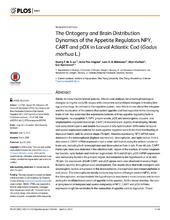| dc.description.abstract | Similar to many marine teleost species, Atlantic cod undergo remarkable physiological changes during the early life stages with concurrent and profound changes in feeding biology and ecology. In contrast to the digestive system, very little is known about the ontogeny and the localization of the centers that control appetite and feed ingestion in the developing brain of fish. We examined the expression patterns of three appetite regulating factors (orexigenic: neuropeptide Y, NPY; prepro-orexin, pOX and anorexigenic: cocaine- and amphetamine-regulated transcript, CART) in discrete brain regions of developing Atlantic cod using chromogenic and double fluorescent in situ hybridization. Differential temporal and spatial expression patterns for each appetite regulator were found from first feeding (4 days post hatch; dph) to juvenile stage (76 dph). Neurons expressing NPY mRNA were detected in the telencephalon (highest expression), diencephalon, and optic tectum from 4 dph onward. CART mRNA expression had a wider distribution along the anterior-posterior brain axis, including both telencephalon and diencephalon from 4 dph. From 46 dph, CART transcripts were also detected in the olfactory bulb, region of the nucleus of medial longitudinal fascicle, optic tectum and midbrain tegmentum. At 4 and 20 dph, pOX mRNA expression was exclusively found in the preoptic region, but extended to the hypothalamus at 46 and 76 dph. Co-expression of both CART and pOX genes were also observed in several hypothalamic neurons throughout larval development. Our results show that both orexigenic and anorexigenic factors are present in the telencephalon, diencephalon and mesencephalon in cod larvae. The telencephalon mostly contains key factors of hunger control (NPY), while the diencephalon, and particularly the hypothalamus may have a more complex role in modulating the multifunctional control of appetite in this species. As the larvae develop, the overall progression in temporal and spatial complexity of NPY, CART and pOX mRNAs expression might be correlated to the maturation of appetite control regulation. These observations suggest that teleost larvae continue to develop the regulatory networks underlying appetite control after onset of exogenous feeding. | en_US |

